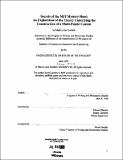| dc.contributor.advisor | Edward Barrett. | en_US |
| dc.contributor.author | Gottlieb, Mark Louis, 1974- | en_US |
| dc.contributor.other | MIT Program in Writing & Humanistic Studies. | en_US |
| dc.date.accessioned | 2008-12-08T22:09:36Z | |
| dc.date.available | 2008-12-08T22:09:36Z | |
| dc.date.copyright | 1998 | en_US |
| dc.date.issued | 1998 | en_US |
| dc.identifier.uri | http://hdl.handle.net/1721.1/43725 | |
| dc.description | Thesis (S.B.)--Massachusetts Institute of Technology, Dept. of Humanities, Program in Writing and Humanistic Studies, 1998. | en_US |
| dc.description.abstract | This is an exploration of the rules and guidelines that underlie the structure of a multi-puzzle contest (a competition consisting of one large puzzle made up of a number of smaller constituent puzzles). The MIT Mystery Hunt, a multi-puzzle contest held on campus each January, is the second-largest annual event of this nature in the United States. The theories put forth in this exploration were culled from personal experience. Having played in four MIT Mystery Hunts and constructed two, as well as participating in other multi-puzzle contests such as the Miami Herald Tropic Hunt, the Random House $10,000 Trivia Challenge, and the National Puzzlers' League convention extravaganza, I am familiar with the specific format in question. Furthermore, I have a firsthand understanding, from both sides of the contest, of what is necessary and what is optional and, more importantly, what works and what does not. It was found that the structural framework of a multi-puzzle contest is rather loose; most of the guidelines and elements are optional. The only necessary aspects are the most basic structural components: an endgame and a number of individual puzzles. However, while a multi-puzzle contest can technically work without a majority of the elements discussed, many of these must be included for such a contest to be a successful form of entertainment. The most vital aspects are theme and variety; others that should be included are puzzles that use the available geography and experimental puzzles. Ultimately, the puzzle maker should design the multi-puzzle contest he would most like to participate in himself. | en_US |
| dc.description.statementofresponsibility | by Mark Louis Gottlieb. | en_US |
| dc.format.extent | 77 leaves | en_US |
| dc.language.iso | eng | en_US |
| dc.publisher | Massachusetts Institute of Technology | en_US |
| dc.rights | M.I.T. theses are protected by
copyright. They may be viewed from this source for any purpose, but
reproduction or distribution in any format is prohibited without written
permission. See provided URL for inquiries about permission. | en_US |
| dc.rights.uri | http://dspace.mit.edu/handle/1721.1/7582 | en_US |
| dc.subject | Program in Writing and Humanistic Studies | en_US |
| dc.title | Secrets of the MIT mystery hunt : an exploration of the theory underlying the construction of a multi-puzzle contest | en_US |
| dc.title.alternative | Exploration of the theory underlying the construction of a multi-puzzle contest | en_US |
| dc.type | Thesis | en_US |
| dc.description.degree | S.B. | en_US |
| dc.contributor.department | MIT Program in Writing & Humanistic Studies | |
| dc.identifier.oclc | 42019431 | en_US |
